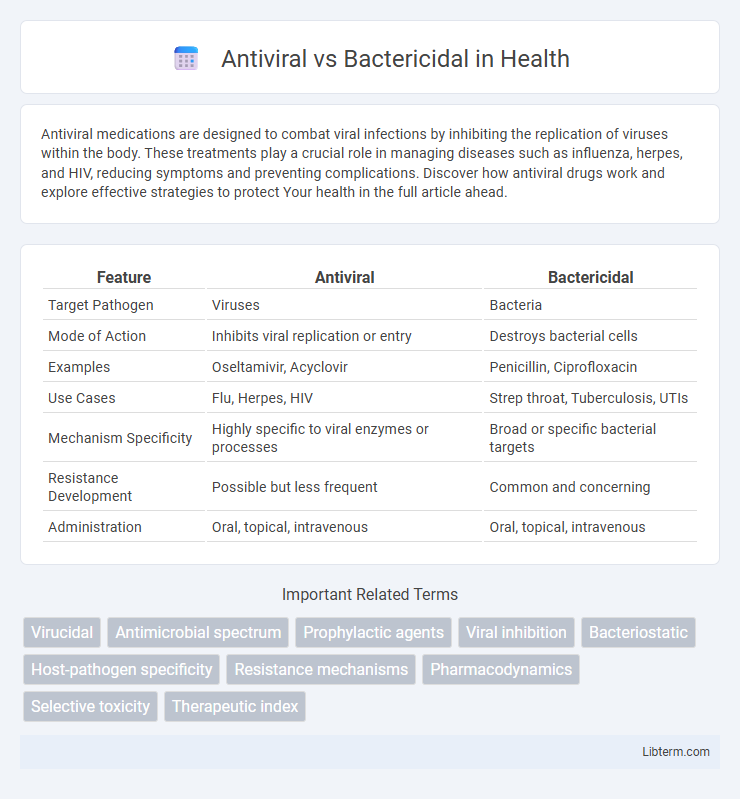Antiviral medications are designed to combat viral infections by inhibiting the replication of viruses within the body. These treatments play a crucial role in managing diseases such as influenza, herpes, and HIV, reducing symptoms and preventing complications. Discover how antiviral drugs work and explore effective strategies to protect Your health in the full article ahead.
Table of Comparison
| Feature | Antiviral | Bactericidal |
|---|---|---|
| Target Pathogen | Viruses | Bacteria |
| Mode of Action | Inhibits viral replication or entry | Destroys bacterial cells |
| Examples | Oseltamivir, Acyclovir | Penicillin, Ciprofloxacin |
| Use Cases | Flu, Herpes, HIV | Strep throat, Tuberculosis, UTIs |
| Mechanism Specificity | Highly specific to viral enzymes or processes | Broad or specific bacterial targets |
| Resistance Development | Possible but less frequent | Common and concerning |
| Administration | Oral, topical, intravenous | Oral, topical, intravenous |
Introduction to Antiviral and Bactericidal Agents
Antiviral agents target viruses by inhibiting viral replication, preventing the spread of infections such as influenza, HIV, and herpes. Bactericidal agents kill bacteria directly, making them essential in treating bacterial infections like pneumonia, tuberculosis, and staphylococcal infections. Understanding the mechanisms and applications of both antiviral and bactericidal agents is crucial for effective disease management and antimicrobial therapy.
Defining Antiviral Medications
Antiviral medications specifically target viral infections by inhibiting the replication process of viruses within host cells, differing fundamentally from bactericidal agents that destroy bacteria. These drugs interfere with viral enzymes or prevent the virus from entering or exiting host cells, effectively reducing viral load and disease severity. Common antiviral classes include protease inhibitors, reverse transcriptase inhibitors, and neuraminidase inhibitors, each tailored to combat specific viral pathogens like HIV, influenza, or herpes simplex virus.
Understanding Bactericidal Agents
Bactericidal agents are chemical substances or antibiotics that kill bacteria by disrupting cell walls, inhibiting essential enzymes, or interfering with metabolic processes, ensuring the complete elimination of bacterial infections. Unlike antiviral drugs that target viral replication mechanisms, bactericidal agents specifically act on bacterial pathogens, making them crucial in treating diseases caused by harmful bacteria such as Streptococcus, Staphylococcus, and Escherichia coli. The effectiveness of bactericidal agents depends on factors like bacterial growth phase, drug concentration, and resistance mechanisms, highlighting the importance of accurate diagnosis and appropriate antibiotic selection in clinical practice.
Mechanisms of Action: How Antivirals Work
Antiviral drugs target specific stages of the viral life cycle, such as entry inhibition, replication interference, or assembly disruption, to prevent viruses from multiplying and spreading. These medications often inhibit viral enzymes like reverse transcriptase, protease, or neuraminidase, effectively blocking the synthesis of viral components essential for infection. Unlike bactericidal agents that kill bacteria by disrupting cell wall synthesis or protein production, antivirals focus on halting virus proliferation within host cells.
Mechanisms of Action: How Bactericidals Work
Bactericidal agents eliminate bacteria by disrupting essential cellular processes such as cell wall synthesis, protein production, or DNA replication, leading to bacterial cell death. Common mechanisms include targeting peptidoglycan layers to induce osmotic lysis or inhibiting ribosomal function to halt protein synthesis. These actions contrast with antivirals, which typically interfere with viral replication rather than directly destroying the pathogen.
Key Differences Between Antivirals and Bactericidals
Antivirals specifically target viruses by inhibiting their replication processes, while bactericidals kill bacteria directly by disrupting cell walls or essential metabolic functions. Antivirals are used to treat viral infections such as influenza, HIV, and herpes, whereas bactericidals are effective against bacterial pathogens like Staphylococcus aureus and Escherichia coli. The mechanisms of action and therapeutic applications of antivirals and bactericidals differ fundamentally due to the distinct biological structures of viruses and bacteria.
Common Diseases Treated by Antivirals
Antiviral medications primarily target viral infections such as influenza, herpes simplex, HIV/AIDS, and hepatitis B and C, preventing viral replication and reducing disease severity. Unlike bactericidal agents that eliminate bacteria causing infections like strep throat or tuberculosis, antivirals are effective against a range of viral pathogens, including respiratory syncytial virus (RSV) and cytomegalovirus (CMV). The specific action of antivirals on viruses highlights their essential role in managing diseases caused by viruses rather than bacteria.
Common Infections Treated by Bactericidals
Bactericidal agents effectively target bacterial infections such as strep throat, urinary tract infections, and bacterial pneumonia by killing the bacteria directly. Commonly prescribed bactericidal antibiotics include penicillins, cephalosporins, and aminoglycosides, which disrupt cell wall synthesis or protein production in bacteria. These medications are essential for treating infections caused by susceptible bacteria and preventing the spread of harmful pathogens.
Resistance and Challenges in Treatment
Antiviral agents target viral replication mechanisms, facing challenges due to rapid mutation rates that lead to resistance, complicating effective treatment options. Bactericidal drugs eliminate bacteria by disrupting cell walls or vital processes, yet resistance emerges through genetic mutations and horizontal gene transfer, reducing drug efficacy. Both antiviral and bactericidal treatments require continuous development to overcome resistance mechanisms and address challenges such as drug toxicity and limited therapeutic windows.
Choosing the Right Treatment: Antiviral vs Bactericidal
Choosing the right treatment depends on identifying the infection type: antiviral medications target viruses by inhibiting replication, while bactericidal agents eliminate bacteria through cell wall disruption or metabolic interference. Accurate diagnosis through laboratory tests like PCR or cultures ensures appropriate selection, minimizing resistance risks and enhancing efficacy. Understanding pathogen specificity and drug mechanism is essential for optimizing clinical outcomes in viral versus bacterial infections.
Antiviral Infographic

 libterm.com
libterm.com